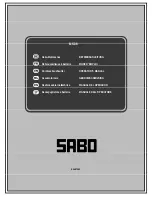
7
2.4.2 Electric circuit
See Figure 4
The main components of the electric circuit and
the electronic components are as follows:
1
2
3
4
Socket
Start switch
Motor
Microswitch
How the machine
works
3
Components and functional parts
2.4
Machine adjustement
3.1
4
5
1
2
3
Size 18 spanner.
Keys to adjust the height and depth of the
teeth.
Wedges to adjust the tip of the key.
Recessed wedges to cut cross-shaped keys.
Set of allen keys (2, 2.5, 3, 4, 5).
2.4.1 Accesories
See Figure 3
2.4.3 2-sided clamp
See Figure 5
The clamp is designed to secure a different family
of keys on each side. The figure shows the possibi-
lities for cutting on each side of the clamp.
1)
Cutting the key with support on the back:
- Keys with normal blade
- Keys with narrow blade
2)
Cutting by means of clamping the key by the
guide (profile).
3.1.1 Control and adjustment of the side distance
•
Place the two adjustment keys (1) in the clamps, so
that the head of the adjustment key rests against
the inner stop of side 1 or 2 of the clamp.
•
Then tighten the clamps.
•
Move the clamps with the adjustment keys (1)
towards the tracer point (I) and the milling cutter
(F), so that the adjustment keys are in the correct
position in respect of the tracer point and milling
cutter. This is done by moving the slide backwards
and keeping it in that position with the help of
the handle (M), moving the slide to the right with
the help of the arm (B), thereby releasing the
slide, and then moving the slide gently over the
tracer point (I) and milling cutter (F).
See Figure 6
•
If the grooves of the adjustment key do not coin-
cide properly with the tracer point and the milling
cutter, proceed as follows:
•
By gently loosening the shaft screws (T), you will be
able to move the milling cutter to the right or left.
You have to move the milling cutter to a position in
which it coincides with the groove of the correspon-
ding adjustment key. To carry out this operation,
you have to remove the motor guard first.
•
The distance is now perfectly adjusted, with the
tracer point and milling cutter coinciding with the
respective recesses of the adjustment keys. Now
tighten the shaft screws (T).
3.1.2
Control and adjustment of the cutting depth
•
Place the two adjustment keys (1) in the clamps, so
that the head of the adjustment key rests against
the inner stop of side 1 or 2 of the clamp..
•
Move the clamps with the adjustment keys (1)
towards the tracer point (I) and the milling cutter
(F), so that the adjustment keys rest on the tracer
point and the milling cutter. The machine slide can
be released in the following way: move the slide
backwards and keeping it in that position with the
help of the lever (M), move the slide to the right,
with the help of the arm (B). To lock the slide again,
reverse the process, with the slide midway along
its travel. Move the slide back with the help of the
handle (M) and keeping it in that position, move
the slide to the left with the help of the arm (B).
With the slide as far to the left as possible, gently
release the slide so that it becomes locked.
•
Turn the milling cutter by hand. If it gently rubs the
adjustment keys, the machine is properly adjusted.
•
If the milling cutter turns freely, without rubbing,
this indicates that it is to far back in respect of the
tracer point and is not cutting deeply enough. On
the other hand, if the milling cutter becomes jam-
med up against the adjustment key, this indicates
that it is too far forward in respect of the tracer
point and is cutting too deeply.
•
If either of these situations should occur, proceed as
follows:
-
Undo the screw (L) securing the tracer point (I)
and turn the micrometric screw (H).
See Figure 7.
-
Move the tracer point forwards or backwards
until the milling cutter turns freely and rubs
English


























